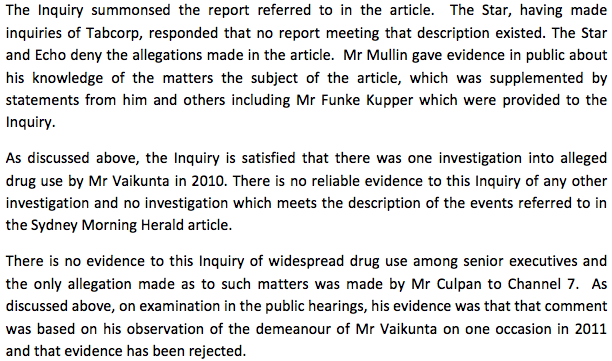The conclusion of the investigation into The Star appears to be just that.
 |
| Photo from here |
The media must have thought all their Christmasses had come at once - the Labor government provided a constant stream of scandal, and whilst the O'Farrell government has hardly been lily white, there hasn't been the same level of rolling chaos. This inquiry promised to change that.
The story got significant coverage on television too - Channel 7 news and the ABC's 730 report broadcast stories about The Star that purported to shed light on what was going on.
The Star had to bear some responsibility for the level of the coverage after it leaked some sms's and emails to the media. This was done, presumably, to shift the media's narrative after a number of stories had been published that were not only critical of the casina but also made a number of damaging insinuations.
The level of build-up suggested that the report, once it was released, would be second only to the FWA report into Craig Thomson.
Except, of course, it wasn't. In fact, the report even took time to criticise the media - the executive summary goes so far as to quote the Media Alliance Code of Ethics and insinuated that certain parts of the media had been less than strictly observant of the obligations it imposes.
That was always going to be provocative, given that past form suggests that certain parts of the media cannot be relied upon to read much of any report other than what appears in the executive summary.
Suffice to say, the Terror was less than impressed.
Whilst I'm not aware of any similar piece published by the SMH, their State Political Editor Sean Nicholls linked to the editorial on twitter and said this:
The editorial unloads on Gail Furness SC, the barrister who was given responsibility for producing the report.
The paragraph below puzzled me:
The first sentence has nothing to do with the second - the report explained that whilst the media had breathlessly broadcast allegations about The Star and insinuated a deeply entrenched culture of sexual harassment and drug use, those allegations were contradicted by the evidence presented to the inquiry.
In many cases, the evidence to the inquiry contracted the stories published in the media. For example:
The below paragraph in the editorial puzzled me:
It's clearly incorrect. The report was presented with evidence that directly contradicted the allegations made in the media reports. It's possible that the people speaking to the media were lying or misleading the media, and for that there is perhaps some excuse, but either way at least some responsibility must be sheeted back the media outlets that made allegations that were were in fact untrue.
The most interesting part of the editorial is that at no time does it list the allegations that were, in the writer's opinion, made out. They wrote that it was a whitewash - what finding should have been made by the inquiry? Surely if you write a report such as this you would detail a basis for the allegation?
Experience tells us that journalists are usually pretty good at glossing over details that are inconvenient for the position being taken - and this editorial is no exception.
A proper reading of the report shows that, put simply, there was little or no basis for most of the allegations made. It doesn't take long - the report is only 72 pages long.
There were two main terms of reference:
This is Sid Vaikunta:
 |
| Photo from The Australian |
The conclusions reached by the inquiry are as follows:
The second issue was a broader one, looking at more general issue surrounding the operation of the casino. This was an particularly controversial issue given that (unsurprisingly) the various allegations were enthusiastically reported by the media.
One example surrounded an allegation where a gambler "abused" a dealer, but the gambler was not removed. The report indicates that the "conduct complained of does not automatically warrant exclusion."
Another allegation that attracted significant media attention was the allegation that a "foreign politician" had harassed a dealer and that nothing had been done. This allegation had been broadcast on Channel 7.
The facts? Firstly, it transpired that the person who had spoken to Channel 7 had not witnessed the incident, and was in fact no longer even employed by the casino when it occurred.
The incident report produced by The Star showed the following:
The report also has a detailed section about responsible gambling and responsible service of alcohol. This section was, at least in part, informed by some anonymous information that had been provided to the inquiry.
Without getting stuck into the detail, it appeared that many of the allegations were unfounded, exaggerated or simply distortions of the truth.
There was a detailed section devoted to a line of white powder that was found in a bathroom. An investigation subsequently found that the powder was concrete dust, not cocaine as had been suspected by some.
An ex-employee of the casino made the following allegation:
The facts, it seemed, were substantially different:
The final issue covered was summarised as follows:
Again, the reality was widely divergent:
I'm certainly no great defender of The Star or in fact any other gambling establishment. In fact, by way of example, I've previously criticised O'Farrell for cutting the taxes payable by clubs on their pokie revenue.
However, when this report is actually read, it seems a fair and balanced review of the evidence that was received in light of the terms of reference. The Terror's editorial appears to be an oversensitive lashing out after some well-deserved criticism.
What this means for Grimshaw, and whether there will be further political fall-out, remains to be seen.
















No comments:
Post a Comment